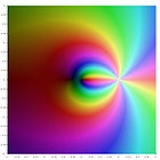
Polylogarithm
Encyclopedia
In mathematics, the polylogarithm (also known as Jonquière) is a special function Lis(z) that is defined by the infinite sum, or power series:

It is in general not an elementary function, unlike the related logarithm
function. The above definition is valid for all complex values of the order s and the argument z where |z| < 1. The polylogarithm is defined over a larger range of z than the above definition allows by the process of analytic continuation
.
The special case s = 1 involves the ordinary natural logarithm
(Li1(z) = −ln(1−z)) while the special cases s = 2 and s = 3 are called the dilogarithm (also referred to as Spence's function
) and trilogarithm respectively. The name of the function comes from the fact that it may alternatively be defined as the repeated integral of itself, namely that

Thus the dilogarithm is an integral of the logarithm, and so on. For nonpositive integer orders s, the polylogarithm is a rational function
.
The polylogarithm also arises in the closed form of the integral of the Fermi–Dirac distribution and the Bose–Einstein distribution and is sometimes known as the Fermi–Dirac integral or the Bose–Einstein integral. Polylogarithms should not be confused with polylogarithmic
functions nor with the offset logarithmic integral which has a similar notation.
of the complex logarithm
Ln(z) so that −π < Im(μ) ≤ π. Also, all exponentiation will be assumed to be single-valued: zs = exp(s ln(z)).
Depending on the order s, the polylogarithm may be multi-valued. The principal branch of Lis(z) is taken to be that given for |z| < 1 by the above series definition and taken to be continuous except on the positive real axis, where a cut is made from z = 1 to ∞ such that axis is placed on the lower half plane of z. In terms of μ, this amounts to −π < arg(−μ) ≤ π. The discontinuity of the polylogarithm in dependence on μ can sometimes be confusing.
For real argument z, the polylogarithm of real order s is real if z < 1, and its imaginary part for z ≥ 1 is :

Going across the cut, if δ is an infinitesimally small positive real number, then:

Both can be concluded from the series expansion (see below) of Lis(eµ) about µ = 0.
The derivatives of the polylogarithm follow from the defining power series:


The square relationship is easily seen from the duplication formula (see also ):

Note that Kummer's function
obeys a very similar duplication formula. This is a special case of the multiplication formula, for any integer p:

which can be proved using the series definition of the polylogarithm and the orthogonality of the exponential terms (e.g. see discrete Fourier transform
).
Another important property, the inversion formula, involves the Hurwitz zeta function or the Bernoulli polynomials
and is found under relationship to other functions below.
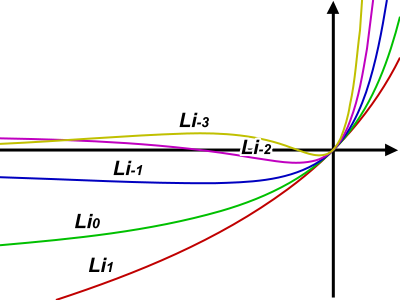
For particular cases, the polylogarithm may be expressed in terms of other functions (see below). Particular values for the polylogarithm may thus be found as particular values of these other functions.
1. For integer values of the polylogarithm order, the following explicit expressions are obtained by repeated application of z·∂/∂z to Li1(z):






Accordingly the polylogarithm reduces to a ratio of polynomials in z, and is therefore a rational function
of z, for all nonpositive integer orders. The general case may be expressed as a finite sum:


where S(n,k) are the Stirling numbers of the second kind. Equivalent formulae applicable to negative integer orders are :

and:

where are the Eulerian numbers. All roots of Li−n(z) are distinct and real; they include z = 0, while the remainder is negative and centered about z = −1 on a logarithmic scale. As n becomes large, the numerical evaluation of these rational expressions increasingly suffers from cancellation ; full accuracy can be obtained, however, by computing Li−n(z) via the general relation with the Hurwitz zeta function (see below).
are the Eulerian numbers. All roots of Li−n(z) are distinct and real; they include z = 0, while the remainder is negative and centered about z = −1 on a logarithmic scale. As n becomes large, the numerical evaluation of these rational expressions increasingly suffers from cancellation ; full accuracy can be obtained, however, by computing Li−n(z) via the general relation with the Hurwitz zeta function (see below).
2. Some particular expressions for half-integer values of the argument z are:



where ζ is the Riemann zeta function. No formulae of this type are known for higher integer orders . However, one has for instance:

involving the alternating double sum .
.
3. As a straightforward consequence of the series definition, values of the polylogarithm at the pth complex roots of unity are given by the Fourier sum
:

where ζ is the Hurwitz zeta function. For Re(s) > 1, where Lis(1) is finite, the relation also holds with m = 0 or m = p. While this formula is not as simple as that implied by the more general relation with the Hurwitz zeta function listed under relationship to other functions below, it has the advantage of applying to positive integer values of s as well. As usual, the relation may be inverted to express ζ(s, m⁄p) for any m = 1, ..., p as a Fourier sum of Lis(exp(2πi k⁄p)) over k = 1, ..., p.

It is in general not an elementary function, unlike the related logarithm
Logarithm
The logarithm of a number is the exponent by which another fixed value, the base, has to be raised to produce that number. For example, the logarithm of 1000 to base 10 is 3, because 1000 is 10 to the power 3: More generally, if x = by, then y is the logarithm of x to base b, and is written...
function. The above definition is valid for all complex values of the order s and the argument z where |z| < 1. The polylogarithm is defined over a larger range of z than the above definition allows by the process of analytic continuation
Analytic continuation
In complex analysis, a branch of mathematics, analytic continuation is a technique to extend the domain of a given analytic function. Analytic continuation often succeeds in defining further values of a function, for example in a new region where an infinite series representation in terms of which...
.
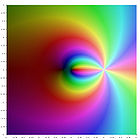 |
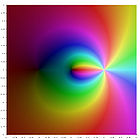 |
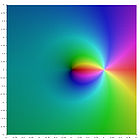 |
 |
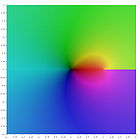 |
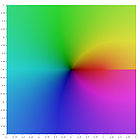 |
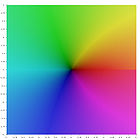 |
 |
 |
 |
 |
 |
 |
 |
The special case s = 1 involves the ordinary natural logarithm
Natural logarithm
The natural logarithm is the logarithm to the base e, where e is an irrational and transcendental constant approximately equal to 2.718281828...
(Li1(z) = −ln(1−z)) while the special cases s = 2 and s = 3 are called the dilogarithm (also referred to as Spence's function
Spence's function
In mathematics, Spence's function, or dilogarithm, denoted as Li2, is a particular case of the polylogarithm. Lobachevsky's function and Clausen's function are closely related functions...
) and trilogarithm respectively. The name of the function comes from the fact that it may alternatively be defined as the repeated integral of itself, namely that

Thus the dilogarithm is an integral of the logarithm, and so on. For nonpositive integer orders s, the polylogarithm is a rational function
Rational function
In mathematics, a rational function is any function which can be written as the ratio of two polynomial functions. Neither the coefficients of the polynomials nor the values taken by the function are necessarily rational.-Definitions:...
.
The polylogarithm also arises in the closed form of the integral of the Fermi–Dirac distribution and the Bose–Einstein distribution and is sometimes known as the Fermi–Dirac integral or the Bose–Einstein integral. Polylogarithms should not be confused with polylogarithmic
Polylogarithmic
A polylogarithmic function in n is a polynomial in the logarithm of n,In computer science, polylogarithmic functions occur as the order of memory used by some algorithms .All polylogarithmic functions are...
functions nor with the offset logarithmic integral which has a similar notation.
Properties
Preliminary note: In the important case where the polylogarithm order s is an integer, it will be represented by n (or −n when negative). It is often convenient to define μ = ln(z) where ln(z) is the principal branchPrincipal branch
In mathematics, a principal branch is a function which selects one branch, or "slice", of a multi-valued function. Most often, this applies to functions defined on the complex plane: see branch cut....
of the complex logarithm
Complex logarithm
In complex analysis, a complex logarithm function is an "inverse" of the complex exponential function, just as the natural logarithm ln x is the inverse of the real exponential function ex. Thus, a logarithm of z is a complex number w such that ew = z. The notation for such a w is log z...
Ln(z) so that −π < Im(μ) ≤ π. Also, all exponentiation will be assumed to be single-valued: zs = exp(s ln(z)).
Depending on the order s, the polylogarithm may be multi-valued. The principal branch of Lis(z) is taken to be that given for |z| < 1 by the above series definition and taken to be continuous except on the positive real axis, where a cut is made from z = 1 to ∞ such that axis is placed on the lower half plane of z. In terms of μ, this amounts to −π < arg(−μ) ≤ π. The discontinuity of the polylogarithm in dependence on μ can sometimes be confusing.
For real argument z, the polylogarithm of real order s is real if z < 1, and its imaginary part for z ≥ 1 is :

Going across the cut, if δ is an infinitesimally small positive real number, then:

Both can be concluded from the series expansion (see below) of Lis(eµ) about µ = 0.
The derivatives of the polylogarithm follow from the defining power series:


The square relationship is easily seen from the duplication formula (see also ):

Note that Kummer's function
Kummer's function
In mathematics, there are several functions known as Kummer's function. One is known as the confluent hypergeometric function of Kummer. Another one, defined below, is related to the polylogarithm...
obeys a very similar duplication formula. This is a special case of the multiplication formula, for any integer p:

which can be proved using the series definition of the polylogarithm and the orthogonality of the exponential terms (e.g. see discrete Fourier transform
Discrete Fourier transform
In mathematics, the discrete Fourier transform is a specific kind of discrete transform, used in Fourier analysis. It transforms one function into another, which is called the frequency domain representation, or simply the DFT, of the original function...
).
Another important property, the inversion formula, involves the Hurwitz zeta function or the Bernoulli polynomials
Bernoulli polynomials
In mathematics, the Bernoulli polynomials occur in the study of many special functions and in particular the Riemann zeta function and the Hurwitz zeta function. This is in large part because they are an Appell sequence, i.e. a Sheffer sequence for the ordinary derivative operator...
and is found under relationship to other functions below.
Particular values

For particular cases, the polylogarithm may be expressed in terms of other functions (see below). Particular values for the polylogarithm may thus be found as particular values of these other functions.
1. For integer values of the polylogarithm order, the following explicit expressions are obtained by repeated application of z·∂/∂z to Li1(z):






Accordingly the polylogarithm reduces to a ratio of polynomials in z, and is therefore a rational function
Rational function
In mathematics, a rational function is any function which can be written as the ratio of two polynomial functions. Neither the coefficients of the polynomials nor the values taken by the function are necessarily rational.-Definitions:...
of z, for all nonpositive integer orders. The general case may be expressed as a finite sum:


where S(n,k) are the Stirling numbers of the second kind. Equivalent formulae applicable to negative integer orders are :

and:

where
 are the Eulerian numbers. All roots of Li−n(z) are distinct and real; they include z = 0, while the remainder is negative and centered about z = −1 on a logarithmic scale. As n becomes large, the numerical evaluation of these rational expressions increasingly suffers from cancellation ; full accuracy can be obtained, however, by computing Li−n(z) via the general relation with the Hurwitz zeta function (see below).
are the Eulerian numbers. All roots of Li−n(z) are distinct and real; they include z = 0, while the remainder is negative and centered about z = −1 on a logarithmic scale. As n becomes large, the numerical evaluation of these rational expressions increasingly suffers from cancellation ; full accuracy can be obtained, however, by computing Li−n(z) via the general relation with the Hurwitz zeta function (see below).2. Some particular expressions for half-integer values of the argument z are:



where ζ is the Riemann zeta function. No formulae of this type are known for higher integer orders . However, one has for instance:

involving the alternating double sum
 .
.3. As a straightforward consequence of the series definition, values of the polylogarithm at the pth complex roots of unity are given by the Fourier sum
Discrete Fourier transform
In mathematics, the discrete Fourier transform is a specific kind of discrete transform, used in Fourier analysis. It transforms one function into another, which is called the frequency domain representation, or simply the DFT, of the original function...
:

where ζ is the Hurwitz zeta function. For Re(s) > 1, where Lis(1) is finite, the relation also holds with m = 0 or m = p. While this formula is not as simple as that implied by the more general relation with the Hurwitz zeta function listed under relationship to other functions below, it has the advantage of applying to positive integer values of s as well. As usual, the relation may be inverted to express ζ(s, m⁄p) for any m = 1, ..., p as a Fourier sum of Lis(exp(2πi k⁄p)) over k = 1, ..., p.
Relationship to other functions
- For z = 1 the polylogarithm reduces to the Riemann zeta function
-

- The polylogarithm is related to Dirichlet eta function and the Dirichlet beta functionDirichlet beta functionIn mathematics, the Dirichlet beta function is a special function, closely related to the Riemann zeta function...
:
-

- where η(s) is the Dirichlet eta function. For pure imaginary arguments, we have:
-

- where β(s) is the Dirichlet beta function.
- The polylogarithm is related to the complete Fermi–Dirac integral as:
-

- The polylogarithm is a special case of the incomplete polylogarithmIncomplete polylogarithmIn mathematics, the Incomplete Polylogarithm function is related to the polylogarithm function. It is sometimes known as the incomplete Fermi–Dirac integral or the incomplete Bose–Einstein integral...
function
- The polylogarithm is a special case of the Lerch Transcendent
- The polylogarithm is related to the Hurwitz zeta function by:
-

- where Γ(1−s) is the gamma functionGamma functionIn mathematics, the gamma function is an extension of the factorial function, with its argument shifted down by 1, to real and complex numbers...
, which causes the relation to fail for positive integer s; a derivation of this formula is given under series representations below. The polylogarithm is consequently also related to the Hurwitz zeta function by :
-

- which holds for 0 ≤ Re(x) < 1 if Im(x) ≥ 0, and for 0 < Re(x) ≤ 1 if Im(x) < 0. Equivalently, for all complex s and for complex z ∉ ]0;1], the inversion formula reads
-

- and for all complex s and for complex z ∉ ]1;∞[
-

- These relations furnish the analytic continuation of the polylogarithm beyond the circle of convergence |z| = 1 of the defining power series. (Note that Erdélyi's corresponding equation is not correct if one assumes that the principal branches of the polylogarithm and the logarithm are used simultaneously.) See below for a simplified formula when s is an integer.
- For positive integer polylogarithm orders s, the Hurwitz zeta function ζ(1−s, x) reduces to Bernoulli polynomialsBernoulli polynomialsIn mathematics, the Bernoulli polynomials occur in the study of many special functions and in particular the Riemann zeta function and the Hurwitz zeta function. This is in large part because they are an Appell sequence, i.e. a Sheffer sequence for the ordinary derivative operator...
, ζ(1−n, x) = −Bn(x) / n, and Jonquière's inversion formula for n = 1, 2, 3, ... becomes:
-

- where again 0 ≤ Re(x) < 1 if Im(x) ≥ 0, and 0 < Re(x) ≤ 1 if Im(x) < 0. Upon restriction of the polylogarithm argument to the unit circle, Im(x) = 0, the left hand side of this formula simplifies to 2 Re(Lin(e2πix)) if n is even, and to 2i Im(Lin(e2πix)) if n is odd. For negative integer orders, on the other hand, the divergence of Γ(s) implies for all z that :
-

- More generally one has for n = 0, ±1, ±2, ±3, ... :
-

-

- The polylogarithm with pure imaginary μ may be expressed in terms of the Clausen functions Cis(θ) and Sis(θ), and vice versa , :
-

- The inverse tangent integral Tis(z) can be expressed in terms of polylogarithms:
-

- The relation in particular implies:
-

-

- which explains the function name.
- The Legendre chi function χs(z) , can be expressed in terms of polylogarithms:
-

- The polylogarithm of integer order can be expressed as a generalized hypergeometric function:
-

-

- In terms of the incomplete zeta functions or "Debye functions" :
-

- the polylogarithm Lin(z) for positive integer n may be expressed as the finite sum :
-

- A remarkably similar expression relates the function Zn(z) to the polylogarithm:
-

Integral representations
Any of the following integral representations furnishes the analytic continuationAnalytic continuationIn complex analysis, a branch of mathematics, analytic continuation is a technique to extend the domain of a given analytic function. Analytic continuation often succeeds in defining further values of a function, for example in a new region where an infinite series representation in terms of which...
of the polylogarithm beyond the circle of convergence |z| = 1 of the defining power series.
- The integral of the Bose–Einstein distribution is expressed in terms of a polylogarithm:
-

- This converges for Re(s) > 0 and all z except for z real and ≥ 1. The polylogarithm in this context is sometimes referred to as a Bose integral or a Bose-Einstein integral.
- The integral of the Fermi-Dirac distribution is also expressed in terms of a polylogarithm:
-

- This converges for Re(s) > 0 and all z except for z real and ≤ −1. The polylogarithm in this context is sometimes referred to as a Fermi integral or a Fermi–Dirac integral .
- A complementary integral representation applies to Re(s) < 0 and to all z except to z real and ≥ 0:
-

- This integral follows from the general relation of the polylogarithm with the Hurwitz zeta function (see above) and a familiar integral representation of the latter.
- The polylogarithm may be rather generally represented by a Hankel contourHankel contourIn mathematics, a Hankel contour is a path in the complex plane which extends from[∞,δ], around the origin counter clockwise and back to[∞,−δ], where δ is an arbitrarily small positive number...
integral . As long as the t = μ pole of the integrand does not lie on the non-negative real axis, and s ≠ 1, 2, 3, ..., we have:
-

- where H represents the Hankel contour. The integrand has a cut along the real axis from zero to infinity, with the axis belonging to the lower half plane of t. The integration starts at +∞ on the upper half plane (Im(t) > 0), circles the origin without enclosing any of the poles t = µ + 2kπi, and terminates at +∞ on the lower half plane (Im(t) < 0). For the case where µ is real and non-negative, we can simply subtract the contribution of the enclosed t = µ pole:
-

- where R is the residueResidue (complex analysis)In mathematics, more specifically complex analysis, the residue is a complex number proportional to the contour integral of a meromorphic function along a path enclosing one of its singularities...
of the pole:
-

- A Hermite-like integral representation valid for all complex z and for all complex s is:
-

- where Γ is the upper incomplete gamma-functionIncomplete gamma functionIn mathematics, the gamma function is defined by a definite integral. The incomplete gamma function is defined as an integral function of the same integrand. There are two varieties of the incomplete gamma function: the upper incomplete gamma function is for the case that the lower limit of...
. Note that all (but not part) of the ln(z) in this expression can be replaced by −ln(1⁄z). A related representation which also holds for all complex s,
-

- avoids the use of the incomplete gamma function, but this integral fails for z on the positive real axis.
Series representations
1. As noted under integral representations above, the Bose-Einstein integral representation of the polylogarithm may be extended to negative orders s by means of Hankel contourHankel contourIn mathematics, a Hankel contour is a path in the complex plane which extends from[∞,δ], around the origin counter clockwise and back to[∞,−δ], where δ is an arbitrarily small positive number...
integration:

where H is the Hankel contour, s ≠ 1, 2, 3, ..., and the t = μ pole of the integrand does not lie on the non-negative real axis. The contourMethods of contour integrationIn the mathematical field of complex analysis, contour integration is a method of evaluating certain integrals along paths in the complex plane.Contour integration is closely related to the calculus of residues, a methodology of complex analysis....
can be modified so that it encloses the poles of the integrand at t − µ = 2kπi, and the integral can be evaluated as the sum of the residuesResidue (complex analysis)In mathematics, more specifically complex analysis, the residue is a complex number proportional to the contour integral of a meromorphic function along a path enclosing one of its singularities...
, :

This will hold for Re(s) < 0 and all μ except where eμ = 1. For 0 < Im(µ) ≤ 2π the sum can be split as:

where the two series can now be identified with the Hurwitz zeta function:

This relation, which has already been given under relationship to other functions above, holds for all complex s ≠ 1, 2, 3, ... and was first derived in .
2. In order to represent the polylogarithm as a power series about µ = 0, we write the series derived from the Hankel contour integral as:

When the binomial powers in the sum are expanded about µ = 0 and the order of summation is reversed, the sum over h can be expressed in closed form:

This result holds for |µ| < 2π and, thanks to the analytic continuation provided by the zeta functions, for all s ≠ 1, 2, 3, ... . If the order s is a positive integer, n, both the term with k = n − 1 and the gamma function become infinite, although their sum does not. One obtains , :

where the sum over h vanishes if k = 0. So, for s = n where n is a positive integer and for |μ| < 2π we have the series:

where Hn denotes the nth harmonic number:

The problem terms now contain −ln(−μ) which, when multiplied by μn−1, will tend to zero as μ → 0, except for n = 1. This reflects the fact that there is a true logarithmic singularityMathematical singularityIn mathematics, a singularity is in general a point at which a given mathematical object is not defined, or a point of an exceptional set where it fails to be well-behaved in some particular way, such as differentiability...
in Lis(z) at s = 1 and z = 1 since:

For s close, but not equal, to a positive integer, the divergent terms in the expansion about µ = 0 can be expected to cause computational difficulties . Note also that Erdélyi's corresponding expansion in powers of ln(z) is not correct if one assumes that the principal branches of the polylogarithm and the logarithm are used simultaneously, since ln(1⁄z) is not uniformly equal to −ln(z).
For nonpositive integer values of s, the zeta function ζ(s − k) in the expansion about µ = 0 reduces to Bernoulli numbers: ζ(−n − k) = −B1+n+k / (1 + n + k). Numerical evaluation of Li−n(z) by this series does not suffer from the cancellation effects that the finite rational expressions given under particular values above exhibit for large n.
3. By use of the identity

the Bose-Einstein integral representation of the polylogarithm (see above) may be cast in the form:

Replacing the hyperbolic cotangent with a bilateral series,

then reversing the order of integral and sum, and finally identifying the summands with an integral representation of the upper incomplete gamma functionIncomplete gamma functionIn mathematics, the gamma function is defined by a definite integral. The incomplete gamma function is defined as an integral function of the same integrand. There are two varieties of the incomplete gamma function: the upper incomplete gamma function is for the case that the lower limit of...
, one obtains:

For both the bilateral series of this result and that for the hyperbolic cotangent, symmetric partial sums from −kmax to kmax converge unconditionally as kmax → ∞. Provided the summation is performed symmetrically, this series for Lis(z) thus holds for all complex s as well as all complex z.
4. Introducing an explicit expression for the Stirling numbers of the second kind into the finite sum for the polylogarithm of nonpositive integer order (see above) one may write:

The infinite series obtained by simply extending the outer summation to ∞ :

turns out to converge to the polylogarithm for all complex s and for complex z with Re(z) < 1⁄2, as can be verified for |−z⁄(1−z)| < 1⁄2 by reversing the order of summation and using:

For the other arguments with Re(z) < 1⁄2 the result follows by analytic continuationAnalytic continuationIn complex analysis, a branch of mathematics, analytic continuation is a technique to extend the domain of a given analytic function. Analytic continuation often succeeds in defining further values of a function, for example in a new region where an infinite series representation in terms of which...
. This procedure is equivalent to applying Euler's transformation to the series in z that defines the polylogarithm.
Asymptotic expansions
For |z| ≫ 1, the polylogarithm can be expanded into asymptotic seriesAsymptotic expansionIn mathematics an asymptotic expansion, asymptotic series or Poincaré expansion is a formal series of functions which has the property that truncating the series after a finite number of terms provides an approximation to a given function as the argument of the function tends towards a particular,...
in terms of ln(−z):


where B2k are the Bernoulli numbers. Both versions hold for all s and for any arg(z). As usual, the summation should be terminated when the terms start growing in magnitude. For negative integer s, the expansions vanish entirely; for non-negative integer s, they break off after a finite number of terms. describes a method for obtaining these series from the Bose-Einstein integral representation (note that his equation 11.2 for Lis(eµ) requires −2π < Im(µ) ≤ 0).
Limiting behavior
The following limitsLimit (mathematics)In mathematics, the concept of a "limit" is used to describe the value that a function or sequence "approaches" as the input or index approaches some value. The concept of limit allows mathematicians to define a new point from a Cauchy sequence of previously defined points within a complete metric...
result from the various representations of the polylogarithm :





Dilogarithm
The dilogarithm is just the polylogarithm with s = 2. An alternate integral expression for the dilogarithm for arbitrary complex z is :

A source of confusion is that some computer algebra systemComputer algebra systemA computer algebra system is a software program that facilitates symbolic mathematics. The core functionality of a CAS is manipulation of mathematical expressions in symbolic form.-Symbolic manipulations:...
s define the dilogarithm as dilog(z) = Li2(1−z).
In the case of real z ≥ 1 the first integral expression for the dilogarithm can be written as
from which expanding ln(t−1) and integrating term by term we obtain
The AbelNiels Henrik AbelNiels Henrik Abel was a Norwegian mathematician who proved the impossibility of solving the quintic equation in radicals.-Early life:...
identity for the dilogarithm is given by
for x ∉ ]1;∞[ and y ∉ ]1;∞[.
This is immediately seen to hold for either x = 0 or y = 0, and for general arguments is then easily verified by differentiation ∂/∂x ∂/∂y. For y = 1−x the identity reduces to EulerLeonhard EulerLeonhard Euler was a pioneering Swiss mathematician and physicist. He made important discoveries in fields as diverse as infinitesimal calculus and graph theory. He also introduced much of the modern mathematical terminology and notation, particularly for mathematical analysis, such as the notion...
's reflection formula
where Li2(1) = ζ(2) = 1⁄6 π2 has been used.
In terms of the new variables u = x/(1−y), v = y/(1−x) the Abel identity reads
which corresponds to the pentagon identity given in .
From the Abel identity for y = x and the square relationship we have LandenJohn LandenJohn Landen was an English mathematician,He was born at Peakirk near Peterborough in Northamptonshire, and died at Milton in the same county...
's identity
and the inversion formula for the dilogarithm reads
and for x ≥ 1 also
Known closed-form evaluations of the dilogarithm at special arguments are collected in the table below. Arguments in the first column are related by reflection x ↔ 1−x or inversion x ↔ 1⁄x to either x = 0 or x = −1; arguments in the third column are all interrelated by these operations.
Historical note: remarked that "The dilogarithm is the only mathematical function with a sense of humor".
Special values of the dilogarithm 

























Polylogarithm ladders
Leonard Lewin discovered a remarkable and broad generalization of a number of classical relationships on the polylogarithm for special values. These are now called polylogarithm ladders. Define as the reciprocal of the golden ratioGolden ratioIn mathematics and the arts, two quantities are in the golden ratio if the ratio of the sum of the quantities to the larger quantity is equal to the ratio of the larger quantity to the smaller one. The golden ratio is an irrational mathematical constant, approximately 1.61803398874989...
as the reciprocal of the golden ratioGolden ratioIn mathematics and the arts, two quantities are in the golden ratio if the ratio of the sum of the quantities to the larger quantity is equal to the ratio of the larger quantity to the smaller one. The golden ratio is an irrational mathematical constant, approximately 1.61803398874989...
. Then two simple examples of results from ladders are
given by and
given by LandenJohn LandenJohn Landen was an English mathematician,He was born at Peakirk near Peterborough in Northamptonshire, and died at Milton in the same county...
. Polylogarithm ladders occur naturally and deeply in K-theoryK-theoryIn mathematics, K-theory originated as the study of a ring generated by vector bundles over a topological space or scheme. In algebraic topology, it is an extraordinary cohomology theory known as topological K-theory. In algebra and algebraic geometry, it is referred to as algebraic K-theory. It...
and algebraic geometryAlgebraic geometryAlgebraic geometry is a branch of mathematics which combines techniques of abstract algebra, especially commutative algebra, with the language and the problems of geometry. It occupies a central place in modern mathematics and has multiple conceptual connections with such diverse fields as complex...
. Polylogarithm ladders provide the basis for the rapid computations of various mathematical constants by means of the BBP algorithm .
Monodromy
The polylogarithm has two branch pointBranch pointIn the mathematical field of complex analysis, a branch point of a multi-valued function is a point such that the function is discontinuous when going around an arbitrarily small circuit around this point...
s; one at z = 1 and another at z = 0. The second branch point, at z = 0, is not visible on the main sheet of the polylogarithm; it becomes visible only when the function is analytically continued to its other sheets. The monodromyMonodromyIn mathematics, monodromy is the study of how objects from mathematical analysis, algebraic topology and algebraic and differential geometry behave as they 'run round' a singularity. As the name implies, the fundamental meaning of monodromy comes from 'running round singly'...
group for the polylogarithm consists of the homotopyHomotopyIn topology, two continuous functions from one topological space to another are called homotopic if one can be "continuously deformed" into the other, such a deformation being called a homotopy between the two functions...
classes of loops that wind around the two branch points. Denoting these two by m0 and m1, the monodromy group has the group presentation
For the special case of the dilogarithm, one also has that wm0 = m0w, and the monodromy group becomes the Heisenberg group (identifying m0, m1 and w with x, y, z) .
- where Γ is the upper incomplete gamma-function
- where R is the residue
-
-
-
- where Γ(1−s) is the gamma function
- The polylogarithm is a special case of the incomplete polylogarithm
- The polylogarithm is related to Dirichlet eta function and the Dirichlet beta function



